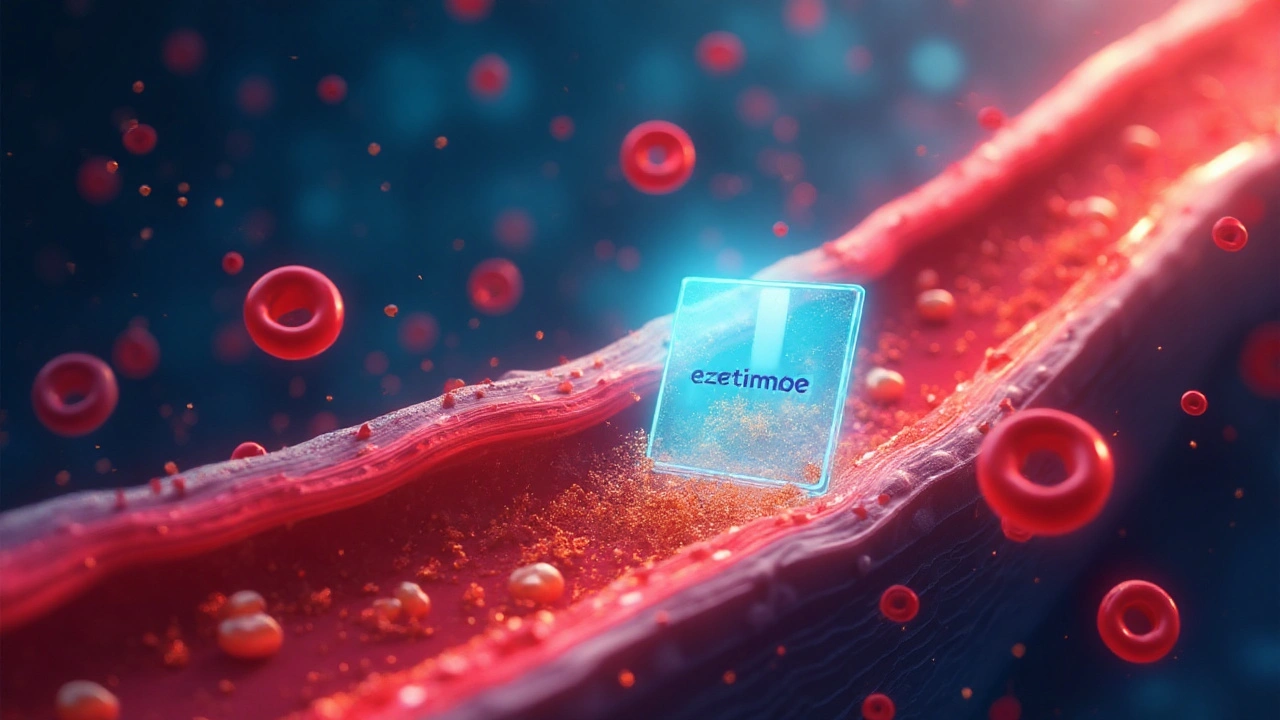LDL‑C Reduction Calculator
If your doctor mentioned high LDL cholesterol and prescribed a pill you haven’t heard of, chances are you’re looking at Zetia. Knowing whether it’s the right choice or if another drug fits better can feel like decoding a secret code. This guide breaks down what Zetia does, who should consider it, and how it measures up against the most common alternatives.
What is Zetia (Ezetimibe)?
Zetia is a cholesterol‑lowering medication that selectively blocks the intestinal absorption of dietary and biliary cholesterol via the NPC1L1 transporter. Approved by the FDA in 2002, it is typically dosed at 10mg once daily, either alone or added to a statin for extra LDL‑C reduction. Clinical trials, most notably the IMPROVE‑IT study, showed an average 18% drop in LDL‑C when paired with simvastatin, translating into a modest cardiovascular benefit.
Major Alternatives to Zetia
When it comes to lowering LDL cholesterol, several drug families compete for a spot in the treatment algorithm. Below are the most widely used options, each defined once with microdata so search engines know what they are.
Statins are a class of HMG‑CoA reductase inhibitors that decrease hepatic cholesterol synthesis. Common agents include atorvastatin, rosuvastatin, and simvastatin. They lower LDL‑C by 30‑50% and have the strongest evidence for reducing heart attacks and strokes.
PCSK9 inhibitors are monoclonal antibodies that block the PCSK9 protein, preventing LDL receptor degradation. Drugs such as evolocumab and alirocumab can cut LDL‑C by up to 60% but are injected subcutaneously and cost significantly more than oral agents.
Bile‑acid sequestrants are non‑absorbable resins that bind bile acids in the gut, forcing the liver to use more cholesterol to make new bile. Examples include cholestyramine and colesevelam; they lower LDL‑C 10‑20% but often cause gastrointestinal upset.
Fibrates are PPAR‑α agonists that mainly reduce triglycerides and raise HDL‑C, with a modest 5‑15% drop in LDL‑C. Gemfibrozil and fenofibrate are typical choices, usually reserved for mixed‑lipid disorders.
Niacin is a vitamin B3 derivative that inhibits hepatic VLDL secretion, lowering LDL‑C by 10‑15% while raising HDL‑C. Side effects (flushing, glucose intolerance) limit its use in modern practice.
How Do These Options Stack Up?
| Drug/Class | Typical LDL‑C reduction | Route | Cost (US$ per month) | Main side effects |
|---|---|---|---|---|
| Zetia (Ezetimibe) | 15‑20% (add‑on) | Oral | ~$30‑$50 | GI upset, rare liver enzyme rise |
| Statins | 30‑50% | Oral | ~$5‑$30 | Myalgia, rare rhabdomyolysis, diabetes risk |
| PCSK9 inhibitors | 50‑60% | Subcutaneous injection | ~$1,400‑$1,600 | Injection site reactions, flu‑like symptoms |
| Bile‑acid sequestrants | 10‑20% | Oral (powder/liquid) | ~$10‑$25 | Constipation, bloating, drug‑drug interactions |
| Fibrates | 5‑15% (LDL‑C) | Oral | ~$15‑$30 | Kidney dysfunction, gallstones |
| Niacin | 10‑15% | Oral | ~$20‑$35 | Flushing, hyperuricemia, glucose intolerance |
When Is Zetia the Right Choice?
Guidelines from major societies (ACC/AHA, ESC/EAS) reserve Zetia for three main scenarios:
- Patients already on a maximally tolerated statin but still above LDL‑C target.
- Those who cannot tolerate high‑intensity statins due to muscle pain or liver enzyme elevation.
- People with statin‑intolerance who need a modest LDL‑C drop while awaiting newer therapies.
Because Zetia works in the gut rather than the liver, it has a minimal impact on the CYP450 system-meaning fewer drug‑drug interactions than statins. This makes it attractive for patients on multiple meds, such as those with HIV, transplant recipients, or elderly polypharmacy cases.

Side‑Effect Profile Compared
Every medication carries trade‑offs. Below is a quick glance at safety considerations:
- Zetia: Generally well‑tolerated; mild diarrhea or abdominal cramping in ~5% of users. Rarely raises liver enzymes, so periodic LFT monitoring is advised.
- Statins: Muscle aches are common; serious rhabdomyolysis is <0.1% but feared. Slight increase in new‑onset diabetes (≈0.5% per year).
- PCSK9 inhibitors: Injection site pain; very low systemic toxicity. No major liver or muscle issues.
- Bile‑acid sequestrants: Constipation and interference with absorption of fat‑soluble vitamins; can lower the efficacy of other oral drugs (e.g., warfarin).
- Fibrates: Risk of gallstones and, when combined with statins, higher chance of rhabdomyolysis.
- Niacin: Intensive flushing (often mitigated with aspirin), worsening of gout, and insulin resistance.
Cost and Access Considerations
Affordability often decides which drug a patient actually uses. Generic Zetia (ezetimibe) hit the market in 2017, dropping the price to roughly $30‑$50 per month in the U.S. Statins remain the cheapest, especially when generic. PCSK9 inhibitors, despite their potency, still cost over $1,500 a month, limiting use to patients with familial hypercholesterolemia or established ASCVD who have failed other therapies.
Insurance formularies usually place Zetia in a middle tier, requiring a modest co‑pay. Bile‑acid sequestrants and fibrates are generally covered with low co‑pays, but their tolerability issues often lead to discontinuation.
Practical Tips for Patients and Clinicians
- Start low, go slow: If adding Zetia to a statin, begin with 10mg daily and assess LDL‑C after 4‑6 weeks.
- Monitor labs: Check baseline liver enzymes and repeat at 3 months, especially if using statins simultaneously.
- Consider timing with meals: Take Zetia with or without food; consistency helps avoid gastrointestinal upset.
- Check for interactions: While Zetia has few CYP interactions, it can increase the levels of certain cholesterol absorption inhibitors; always review medication list.
- Educate on side effects: Inform patients that mild diarrhea usually resolves; advise them to report any persistent muscle pain.
Related Concepts and Next‑Level Topics
Understanding Zetia’s place in therapy also means grasping a few broader ideas:
- LDL‑C targets: Current guidelines aim for <70mg/dL for very high‑risk patients and <100mg/dL for moderate risk.
- Cardiovascular risk calculators: Tools like the ACC/AHA ASCVD risk estimator help decide when to intensify therapy.
- Lifestyle foundation: Dietary changes (Mediterranean diet), regular aerobic exercise, and weight loss can cut LDL‑C 5‑10% without any drug.
- Genetic testing: For patients with refractory hypercholesterolemia, testing for LDLR, APOB, or PCSK9 mutations guides use of PCSK9 inhibitors.
Readers interested in digging deeper might explore topics such as “Statin‑associated muscle symptoms,” “PCSK9 inhibitor insurance pathways,” or “The role of ezetimibe in the IMPROVE‑IT trial.”
Bottom Line
Zetia offers a modest LDL‑C reduction with a clean safety profile, making it an excellent add‑on for statin‑treated patients who still miss their targets or cannot tolerate higher‑dose statins. It isn’t as powerful as PCSK9 inhibitors, nor as cheap as generic statins, but its oral route and low interaction risk often tip the balance in real‑world practice.

Frequently Asked Questions
Can I take Zetia instead of a statin?
Zetia can be used alone, but its LDL‑C‑lowering effect (about 15‑20%) is weaker than any statin. Guidelines recommend it as a supplement to a statin, not a full replacement, unless a patient has absolute statin intolerance.
Is there any diet restriction when taking Zetia?
No special diet is required. Because Zetia blocks cholesterol absorption, a high‑fat meal won’t boost its effect, but taking it with food can reduce mild stomach upset for some people.
How long does it take to see a change in my cholesterol numbers?
LDL‑C typically falls within 2‑4 weeks of starting Zetia. Doctors usually repeat a lipid panel after 6‑8 weeks to confirm the degree of reduction.
Are there any serious side effects I should watch for?
Serious side effects are rare. The main concerns are persistent diarrhea, abdominal pain, or a significant rise in liver enzymes. If you notice dark urine, yellowing of the skin, or severe muscle pain, seek medical attention immediately.
Can I combine Zetia with a PCSK9 inhibitor?
Yes, clinicians sometimes stack all three (statin+Zetia+PCSK9 inhibitor) for patients with very high cardiovascular risk. This triple therapy can lower LDL‑C by up to 80% but is expensive and requires close monitoring.





alaa ismail
September 26, 2025 AT 11:36Zetia’s not magic, but it’s a decent backup when statins wreck your muscles. I’ve seen patients on it for years with zero issues-just a quiet little pill that does its job without drama.
Zoe Bray
September 26, 2025 AT 23:03From a clinical pharmacology standpoint, ezetimibe’s mechanism of action-specific inhibition of the NPC1L1 transporter-offers a complementary pathway to statin-mediated HMG-CoA reductase inhibition. The IMPROVE-IT trial demonstrated a statistically significant, albeit modest, reduction in major adverse cardiovascular events when combined with simvastatin, suggesting additive pleiotropic benefits beyond LDL-C lowering alone.
Its minimal CYP450 interaction profile renders it particularly advantageous in polypharmacy populations, including those on protease inhibitors or calcineurin inhibitors, where metabolic competition is a critical consideration.
Nevertheless, its efficacy ceiling remains constrained compared to PCSK9 inhibitors or high-intensity statins, and cost-effectiveness analyses must weigh marginal benefit against incremental expenditure in low-risk cohorts.
Girish Padia
September 27, 2025 AT 15:08People take this stuff like candy. Meanwhile, real people eat less junk, walk more, and stop drinking soda. No pill fixes laziness.
Carolyn Woodard
September 29, 2025 AT 04:52I’ve been thinking about how we define ‘success’ in lipid management. Is it just about hitting a number on a lab report? Or is it about quality of life, long-term safety, and patient autonomy? Zetia sits in this weird space-it’s not flashy, doesn’t make headlines, but for some, it’s the only thing that lets them live without constant muscle pain or anxiety about side effects.
It’s not a cure. It’s not even the strongest tool. But sometimes, the most ethical choice isn’t the most aggressive one.
Allan maniero
September 29, 2025 AT 07:15It’s fascinating how the medical community has shifted from ‘bigger is better’ to ‘right tool for the right person.’ Statins are still the gold standard, no question-but Zetia’s role as a gentle, additive agent makes sense in the context of individualized care, especially for older adults or those with complex comorbidities. The fact that it’s oral, low-cost, and has such a clean safety profile means it’s often the sensible middle ground between doing nothing and going full nuclear with PCSK9 inhibitors.
And honestly? I appreciate that it doesn’t pretend to be something it’s not. It doesn’t promise miracles. It just… helps.
Anthony Breakspear
September 29, 2025 AT 12:48Statins are the muscle car of cholesterol meds-fast, loud, gets the job done but might blow a gasket. Zetia? That’s your reliable old Honda Civic. Doesn’t win races, but it starts every damn morning, gets you to work, and costs less than your monthly coffee habit. If your statin’s wrecking your legs, Zetia’s your new best friend. No drama. No drama.
Saket Modi
September 30, 2025 AT 21:53meh. i just take fish oil and ignore it. 🤷♂️
Chris Wallace
October 1, 2025 AT 03:34I’ve been on Zetia for three years now, after a bad reaction to rosuvastatin. Honestly, I didn’t expect much-but my LDL dropped from 142 to 98, and I haven’t had a single GI issue. It’s not glamorous, but it’s steady. I’m grateful for that. I know it’s not a ‘blockbuster’ drug, but for people like me, it’s the quiet hero.
I wish more doctors talked about these options like they matter-not just as afterthoughts.
william tao
October 1, 2025 AT 20:19It is profoundly concerning that a drug with a mere 18% LDL reduction-demonstrated in a single trial with marginal clinical benefit-is routinely prescribed as a first-line adjunct, while lifestyle interventions are dismissed as ‘inconvenient.’ The pharmaceutical industry’s influence on guideline committees is not merely a conflict of interest-it is an ethical failure.
Zetia is a textbook example of ‘me-too’ pharmacology: a molecule designed not to cure, but to extend patent life and generate revenue.
Sandi Allen
October 2, 2025 AT 10:59Wait… so you’re telling me the government approved a drug that blocks cholesterol absorption… but didn’t test if it causes… uh… leaky gut? Or worse… does it interact with… GMOs?? I’ve read on a forum that Zetia was originally developed for rats in a secret DARPA project to control population growth through cholesterol manipulation!!
And why is it so cheap?? Because they’re not making it… they’re just… printing it??
Someone’s hiding something. I’ve seen the numbers. The FDA’s database has… redacted entries… after 2015… it’s not coincidence.
John Webber
October 2, 2025 AT 13:10statins are bad for you, i know a guy who got rhabdo from them. zetia is way safer, i think. i dont trust big pharma but this one seems ok. my doc said its fine. i take it with my vitamins. hope it works.